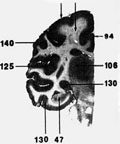The eLitMed.hu medical portal uses computer cookies for convenient operation. Detailed information can be found in the Cookie-policy.
Clinical Neuroscience - 2008;61(01-02)
Content
[MANAGEMENT AFTER DBS IMPLANTATION]
[Deep brain stimulation is a widely used technique for the treatment of movement disorders. This method is a breakthrough in treatment of drug-resistant idiopathic Parkinson’s disease, essential tremor and dystonia. The aim of the present paper is to give an inside overview of the postoperative management like fine tuning of the stimulation and balancing the antiparkinsonian medication. We also discuss the advantage of the use of the (Access Therapy) patient controller. After reviewing the stimulation-related side-effects and their management, the contraindicated medical procedures are discussed.]
[Functional magnetic resonance imaging in neurology (in English language)]
[The present contribution discusses the clinical use of functional MRI (fMRI) and its role in the most common neurological diseases. FMRI was found a reliable and reproducible examination tool resulting in a wide distribution of fMRI methods in presurgical evaluation of epilepsy in determining the relationship of eloquent areas and the epileptic focus. Preliminary data suggest that fMRI using memory paradigms can predict the postoperative memory decline in epilepsy surgery by determining whether a reorganization of memory functions took place. Speech-activated fMRI became the most used tool in determining hemispheric dominance. Visual and senso-motor cortex can also be routinely investigated by fMRI which helps in decision on epilepsy surgery. FMRI combined with EEG is a new diagnostic tool in epilepsy and sleep disorders. FMRI can identify the penumbra after stroke and can provide an additional information on metabolic state of the threatened brain tissue. FMRI has a predictive role in poststroke recovery. In relapsing-remitting MS an adaptive reorganization can be demonstrated by fMRI affecting the visual, motor, and memory systems, despite preserved functional performance. Much more extensive reorganization can be demonstrated in secondary progressive MS. These findings suggest that the different stages of MS are related to different stages of the reorganization and MS becomes progressive when there is no more reserve capacity in the brain for reorganization. FMRI offers the capability of detecting early functional hemodynamic alterations in Alzheimer’s disease before morphological changes. FMRI can be a valuable tool to test and monitor treatment efficacy in AD. FMRI can also provide information about the mechanisms of different therapeutic approaches in Parkinson disorder including drug treatment and deep brain stimulation.]
[FREQUENCY OF DIFFERENT FORMS OF DEMENTIA IN THE DEPARTMENT OF NEUROPATHOLOGY OF THE HUNGARIAN NATIONAL INSTITUTE OF PSYCHIATRY AND NEUROLOGY DURING A 3-YEAR PERIOD]
[Background - Dementia is an increasing problem of the society. The underlying cause of dementia may be difficult to diagnose during life. Only neuropathological examination gives definite diagnosis. Differences in the reported frequency may be related to factors such as the age or gender of subjects with dementia. Materials and methods - In our neuropathology-based study we examined 156 consecutive subjects clinically diagnosed with dementia during a 3-year period. Using histopathological criteria we calculated the frequencies of various disorders causing dementia. We studied the effect of age and gender on these frequencies. Results - Alzheimer’s disease was the most frequent pathologic finding (57.7%) followed by vascular dementia (43%); diffuse Lewy body disease (15.4%); argyrophilic grain dementia (12.1%), various forms of frontotemporal dementia (5.7%); and other (4.5%). The latter comprise prion disease, alcoholic encephalopathy, and hippocampal sclerosis. Mixed pathology was common: concomitant Alzheimer’s disease was present in 41.6% of diffuse Lewy body disease cases and in 49.2% of vascular dementia patients. Pure disease forms are rare: Alzheimer’s disease: 26.3%, vascular dementia: 17.3%, diffuse Lewy body disease: 5.1%, argyrophilic grain dementia: 2.5%. Females were overrepresented among those with Alzheimer’s disease with age at death above 75 years (p <0.02), while males were overrepresented in patients below 75 years with vascular dementia (p <0.05). Conclusions - Our study indicates that the frequency of neurodegenerative dementias is high in the examined patients, but vascular pathology frequently influences the clinical course.]
[COMBINED USE OF PATTERN ELECTRORETINOGRAPHY AND PATTERN VISUAL EVOKED POTENTIALS IN THE NEUROOPHTHALMOLOGICAL DIAGNOSIS]
[Objective - To survey the role of pattern electroretinography (PERG) and pattern visual evoked potentials (VEPs) in the process of clinical evaluation of neuro-ophthalmological cases. The study is illustrated with the electrophysiological findings of 231 patients sent to our laboratory in 2005 because of the suspicion of damage in the optic pathway. Methods - The RETIport program of the ROLAND equipment (Wiesbaden - Germany) was used to record PERGs and VEPs. The recordings were done according to the recommendations of the International Society for Clinical Electrophysiology of Vision. Results - The combined application of PERG and VEP provided useful data on the retino-cortical conduction time and hence demyelinisation. The comparison of the N35/P50 and P50/N90 amplitudes of the PERG recordings greatly promoted the diagnostic procedure. Conclusions - The combined application of PERG and VEP methods is recommended in the assessment of optic nerve function of neuro-ophthalmological patients.]
[THE USE OF STALEVO IN HUNGARY. AN OBSERVATIONAL STUDY]
[The triple combination of levodopa, DDCI and entacapone (Stalevo) is used to treat motor complication in Parkinsonian patients with fluctuation. An observational investigation has been conducted in Hungary to study the effects of Stalevo on the “wearing off” phenomenon and on the quality of life in patients, who are to be treated with. The introduction of Stalevo to the treatment resulted in no changes in the number of patients taking selegiline, amantadine and dopamin agonists, while the number of patients taking anticholinergic drugs were slightly increased. This treatment significantly decreased the average Hoehn-Yahr stadium, as well as the non-motor symptoms, without any remarkable side effect. Stalevo also improved the quality of life, detected by the EQ-5D questionare and the visual analoge scale.]
[Complex regional pain syndrome]
[Complex regional pain syndrome is one of the frequently topics to be discussed during International Congresses. Three books have been published recently by the IASP Press (1994., 2001., 2005.) The aim of my publications is to draw the attention to this syndrome frequently unrecognized, and to summarize an interesting case report.]
[Occlusive hydrocephalus caused by a fourth ventricle arachnoid cyst (in English language)]
[The case history of a woman with occlusive hydrocephalus caused by a fourth ventricle cyst is presented. She had slowly progressive complaints and symptoms - concentration and memory disturbances, low-tempered mood, then slight dizziness, loss of appetite and progressive headache - transitorily misinterpreted for signs of depression. She had been treated by psychotherapy and antidepressants for months. Since she did not improve she was referred to a psychiatric hospital. The rapidly progressing neurological syndrome with worsening headache, gait disturbance and vomiting was finally identified and it turned out to be caused by a fourth ventricle CSF blockage of unknown aetiology. An acute neurosurgical intervention was indicated. It revealed a huge fourth ventricle cyst, undetectable on MRI, occupying the whole ventricle. The resection of its walls resulted in complete recovery. We conclude that since unspecific mental complaints and symptoms suggesting depression may be misleading, their organic origin has to be excluded.]
[THE LANDMARKS OF THE MEASUREMENT OF CEREBRAL BLOOD FLOW]
[History of the measurement of local cerebral blood flow may cover a period of one and a half centuries. Parallel forthcoming of both theoretical and technical development were the key elements of ensuing progress resulting in the present state, when by the aid of in vivo blood flow and metabolic maps, we can visualize locales of brain functioning and their interconnections. Two theoretical landmarks should be mentioned in this historic process. First, the work of Adolf Fick, as the starter of quantitative measurements in this field, and Seymour Kety’s model of a single, homogenously perfused tissue element. The solution of this model, in the form of Kety’s equation is still fundamental to present day blood flow mapping techniques. Among the numerous investigators over the past years, two Hungarian scientist can be named as major contributors. Kálmán Sántha made substantial studies with continuous registration of local cerebral blood flow by the aid of thermocouples, while Emil Pásztor invented the hydrogen clearance method for the measurement of local cerebral blod flow both in human and in animal studies.]
1.
Clinical Neuroscience
[Headache registry in Szeged: Experiences regarding to migraine patients]2.
Clinical Neuroscience
[The new target population of stroke awareness campaign: Kindergarten students ]3.
Clinical Neuroscience
Is there any difference in mortality rates of atrial fibrillation detected before or after ischemic stroke?4.
Clinical Neuroscience
Factors influencing the level of stigma in Parkinson’s disease in western Turkey5.
Clinical Neuroscience
[The effects of demographic and clinical factors on the severity of poststroke aphasia]1.
2.
Clinical Oncology
[Pancreatic cancer: ESMO Clinical Practice Guideline for diagnosis, treatment and follow-up]3.
Clinical Oncology
[Pharmacovigilance landscape – Lessons from the past and opportunities for future]4.
5.












